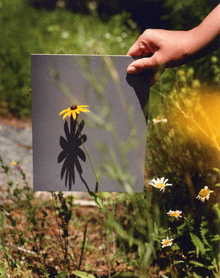
'ROADSIDE WILDFLOWER (BLACK-EYED SUSAN)'
by Bryan Graf; C-print, 10 by 8 inches, 2012 |
You can’t go home again. But you can keep looking for it. And create smart, beautiful, mundane photographs along the way, which is exactly what Bryan Graf has been doing.
The title of his show at MECA’s Institute of Contemporary Art (ICA), “Bryan Graf: Moving across the Interior,” begs the question: the interior of what? A state, an island, the mind? Having grown up in New Jersey, Graf continues to live there and in Maine. As he relates it, while driving home one night during a snow storm, intermittent radio reception allowed just that one phrase of a weather report to come through clearly, “moving across the interior.” That is also what he and ICA director Daniel Fuller recently did as part of the exhibition project — explore the interior of Maine. Photographs from that trip will eventually replace others on view now.
Graf is known for his experimental approach to photographic materials, processes, and subjects, resulting in very diverse bodies of work. The show comprises black-and-white and color photograms, Polaroids, inkjet prints, and C-prints; and in Graf’s case, more is more. His work is best understood cumulatively and viscerally and thus gains from taking over all of ICA’s galleries. The central space, however, is given over to a combined darkroom, teaching studio, and catalogue layout exercise. Nowadays exhibitions frequently incorporate improvisational or participatory elements as often under-conceptualized nods toward trendy audience involvement. Here it may be justified by the artist’s focus on experimentation.
Graf’s work smartly participates in a current reexamination of what defines photography. For him, photography is both medium and content. This is most obvious in the “Shot/Reverse Shot” series, which juxtaposes outdoor photograms with Polaroids of their taking, creating a complexly layered relationship between object, subject, and image. Other works focus on process, selection, and vision, wittily illustrated in “Roadside Wildflower (Black-Eyed Susan),” with its gray cardboard decontextualizing and shape-shifting one specific flower amongst others.
But the images aren’t just clever; many are incredibly beautiful. Modernism has obviously informed a couple of geometric monochromes and the painterly play of color and density in the “Lattice” series, in which layered grids alternately come forward or recede in depth and focus and align themselves into waves of opacity. But Graf uses these tropes of past art only as a formal language, remaining firmly rooted in the real world and in figuration even in the most abstract works, which utilize recognizable objects like gauze and screens. Any distinction between abstraction and representation ultimately does not seem meaningful in Graf’s oeuvre, which is actually quite traditional.
Technically speaking, this is analog photography and manual manipulation with low-tech lights and color filters. The subjects too are traditional, even mundane. “Swamped” includes a list of words that suggests the comforts of intimacy, routine, and corporeal pleasures; there’s nostalgia (a moonrise next to Aunt Mary with her domesticated raccoon), unremarkable nature, and an environment altered by man. It is the constant noticing that counts. Photography seems to have become second nature to the artist, functioning as a tool for relating to the world. A vitrine of decidedly homey materials, including rolls of his uncles’ 8mm home movies of fishing and hunting in Maine, and the aforementioned statewide road trip underscore the narrative, biographical, and time-based subtext of Graf’s work which, collectively, takes on the structure of a journey, a quest with eyes wide open.